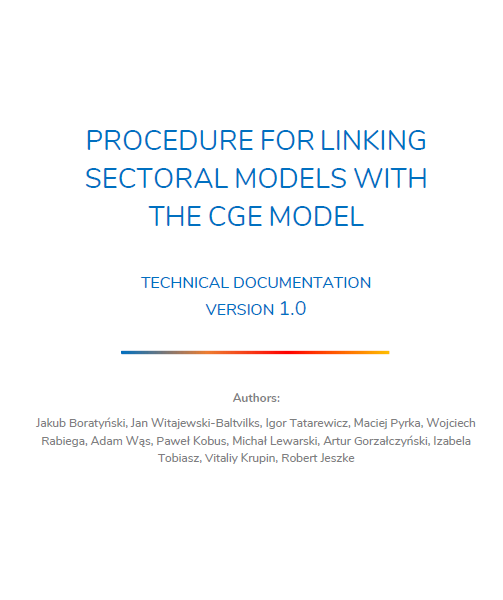
We are pleased to present the technical documentation of the linking the CGE model (d-PLACE) with models for the sectors: energy (MEESA), transport (TR3) and agriculture (EPICA) (Procedure for linking sectoral models with the CGE model), thus completing the available on on our website, a package of information about the tools used in the Center for Climate and Energy Analysis (CAKE).
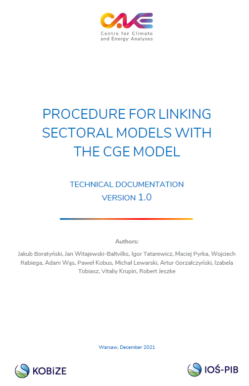 Mechanisms driving emission reduction in individual sectors will not happen in isolation from the rest of the economy – the scale and the pace of emission reduction in one sector critically depend on changes in other sectors. For instance, expected reduction of emissions in manufacturing depends on the price of emission allowances, which, in turn, depends on the speed of diffusion of renewable energy sources and phase-out of coal power plants in electricity sector. On the other hand, the speed of fossil fuel power plants phase-out depends on demand for electricity, which is shaped by the speed of electrification of industry and transport. Similarly, the speed of electrification depends on price of electricity, which is determined by the technological changes in the power sector.
Mechanisms driving emission reduction in individual sectors will not happen in isolation from the rest of the economy – the scale and the pace of emission reduction in one sector critically depend on changes in other sectors. For instance, expected reduction of emissions in manufacturing depends on the price of emission allowances, which, in turn, depends on the speed of diffusion of renewable energy sources and phase-out of coal power plants in electricity sector. On the other hand, the speed of fossil fuel power plants phase-out depends on demand for electricity, which is shaped by the speed of electrification of industry and transport. Similarly, the speed of electrification depends on price of electricity, which is determined by the technological changes in the power sector.
All these interactions between effects in different sectors must be considered in the analysis of climate policy in order to obtain a complete picture of its on impact on European economy. Reflecting all important interdependencies between sectors is not possible in single sectoral model. On the other hand, using a single multisector macroeconomic model (such as dPLACE) does not allow to consider all constraints and complex dynamics that are included in sectoral models. The optimal solution to this problem is building analysis on sectoral and macroeconomic models that are linked with each other. By providing a flow of information across all models in our toolbox and sequential solving we ensure that projections of each individual model is consistent with the projections of the remaining models.
The documentation is available below:
 CAKE_Models_Linking_documentation.pdf (1.7 MiB, 1,160 hits)
CAKE_Models_Linking_documentation.pdf (1.7 MiB, 1,160 hits)
On December 15, 2021, Robert Jeszke, the head of CAKE, gave a very interesting interview to the BiznesAlert about key elements of Fit for 55 package and the challenges of the energy transformation in Poland and about the need to invest in improving efficiency and low-carbon technologies by financing available under the EU ETS.
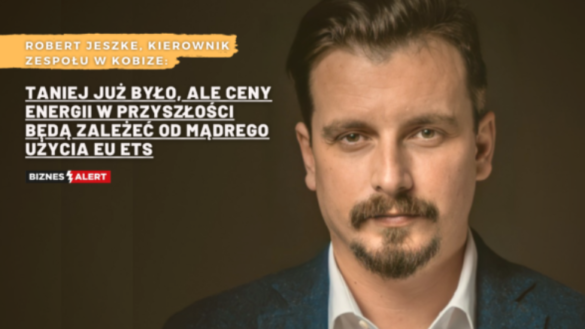
Robert Jeszke spoke about the key changes in the EU ETS – the proposal to extend this system to shipping and the introducing of a separate ETS system for transport and buildings, which is highly controversial due to different marginal costs in both sectors. As a result, there is a serious risk of uneven and unfair distribution of the costs of reducing emissions and concerns about social costs for the most vulnerable customers. Introduction of the CBAM border tax will complement the EU ETS. Its main goal is to protect European companies against the risk of carbon leakage and the relocation of production outside the EU (which is a side effect of emission reduction). CBAM will be a kind of motivator for introducing solutions based on carbon prices in other parts of the world, as all EU trading partners will have to pay this tax if they do not create systems comparable to the EU ETS trading system.
Robert Jeszke also referred to the challenges of the energy transformation in Poland and the need for low-carbon investments. Due to the large needs in the energy sector, the need to accelerate the expenditure of funds on investments is growing. In the first place, these funds will come from the EU ETS, including the Modernization Fund dedicated for this purpose, the Innovation Fund, or the newly established Energy Transformation Fund in Poland. Funds should be allocated to the development of electric and hydrogen car charging infrastructure, and to the development of electricity and heating networks. It seems important to change the approach to the concept of what the outlays themselves are – well-planned outlays become an investment in improving the competitiveness of the Polish economy, and not only at the expense of the EU’s climate and energy policy. It is important to carefully develop and consistently implement the climate and energy policy at the national level, taking into account the Polish specificity of the energy mix, as well as Poland financial capabilities.
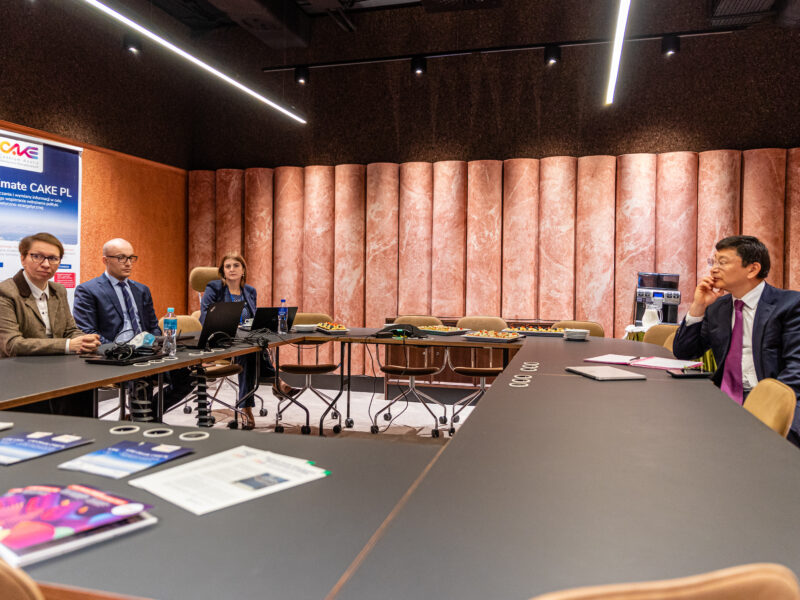
On December 6, 2021, a bilateral meeting was held in the hybrid formula between the CAKE/KOBIZE/ IOŚ-PIB and International Green Technologies and Investment Projects Center NJSC (IGTIPC), which is the operator of the State Register of carbon units of the Republic of Kazakhstan. The meeting took the form of a seminar and concerned the functioning of emission trading systems in the EU and Kazakhstan.
The Polish side presented the experience related to the implementation and operation of the emission allowance trading system, in particular in the field of monitoring, reporting and verification, i.e. elements that are the first necessary to be implemented in the newly created systems. Moreover CAKE represenattives presented research projects in which IOŚ-PIB/KOBiZE are currently participating, i.e. LIFE Climate CAKE PL, LIFE VIIEW 2050 and ECEMF. Part of the discussion concerned the draft of new EU regulations, i.e. “Fit for 55%” package, including in particular the issue of the carbon border tax (CBAM, Carbon Border Adjustment Mechanism), the possible implementation of which will impact directly into the functioning of the emissions trading system in Kazakhstan .
An important point of the meeting was the signing of a Memorandum between IOŚ-PIB/KOBiZE and IGTIPC aimed at developing Polish-Kazakh cooperation in the area of emission trading systems. On behalf of IOŚ-PIB, the document was signed by Mrs Monika Sekuła, Deputy Manager of KOBiZE, IOŚ-PIB, while the representative of the Kazakh side visiting Warsaw was Mr Daniyar Yerenchinov, Chairman of the Board of Directors of IGTIPC.
On the 24th and 25 th of November 2021 CAKE/KOBiZE/ IOŚ-PIB team has a chance to participate in a conference organized by the EC Competence Centre on Modelling (CC-MOD) entitled “2021 EU Conference on modelling for policy support: collaborating across disciplines to tackle key policy challenges”. During the two days of the conference the representatives of CAKE participated actively in the two panles, where they presented some results of the work made out at the LIFE Climate CAKE PL project.
On the 24 th November 2021 during the Session 4: Modelling complex systems for policy, Maciej Pyrka, LIFE Climate CAKE PL – CGE modelling expert presented a presenation entitled “Effects of the Border Tax Adjustment in the EU until 2030”.
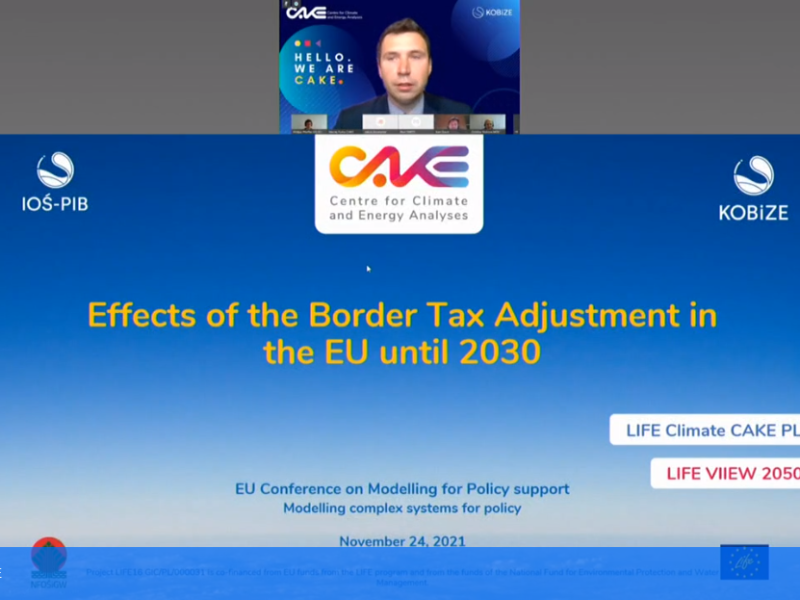
During the conference M. Pyrka presented the main results of the CAKE analysis on the effect of the CBAM (Carbon Border Adjustment Mechanism) on the GHG emissions in the context of more stringent EU climate policy until 2030. M. Pyrka presented also the main scenarios and sectors covered by the analysis included in the report, as well as methodology and main results of modelling concerning the impact on the production in the EU in the sectors covered by border tax and impact on prices and volumes of imports to the EU.
Presentation is available here: link.
The recording is available here: link.
On the 25 th of November 2021 during the Session 6: Multidisciplinary approaches, integrated assessment and model linkages, Jakub Boratynski oraz Jan Witajewski – Baltvilks, LIFE Climate CAKE experts had the opportunity to present a presentation on the models used in the work carried out under the LIFE Climate CAKE PL project entitled “The use of an integrated modeling approach (CGE, sectoral) to support developing long-term climate strategies up to 2050”. During the presentation, Jakub Boratyński presented in detail the principles of combining individual models used by CAKE, MEESA (energy model), d-place general equilibrium model (CGE), transport model (TR3E) and the agricultural model (EPICA). The presentation at the conference also covered some selected results concerning the EU ETS and the energy sector, as well as for sectors not covered by the ETS (the so-called non-ETS). Jan Witajewski – Baltvilks presented the results in terms of the costs of energy transformation for Poland.
Presentation is available here: link.
The recording is available here: link.
More about the conference you can find on the website: 2021 EU Conference on modelling for policy support: collaborating across disciplines to tackle key policy challenges | Knowledge for policy (europa.eu)

We reccomend you to read “How Long Will Combustion Vehicles Be Used in the Polish Transport Sector on the Pathway to Climate Neutrality?“, which was published on the 24 November 2021 at Energies 2021 (Special Issue Trends in the Development of Electric Vehicle).
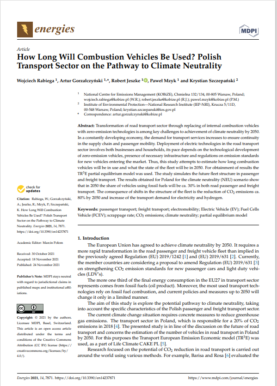 Transformation of road transport sector through replacing of internal combustion vehicles with zero-emission technologies is among key challenges to achievement of climate neutrality by 2050.
Transformation of road transport sector through replacing of internal combustion vehicles with zero-emission technologies is among key challenges to achievement of climate neutrality by 2050.
In a constantly developing economy, the demand for transport services increases to ensure continuity in the supply chain and passenger mobility. Deployment of electric technologies in the road transport sector involves both businesses and households, its pace depends on the technological development of zero-emission vehicles, presence of necessary infrastructure and regulations on emission standards for new vehicles entering the market.
This study attempts to estimate how long combustion vehicles will be in use and what the state of the fleet will be in 2050. For obtainment of results the TR3E partial equilibrium model was used.
The study simulates the future fleet structure in passenger and freight transport. The results obtained for Poland for the climate neutrality (NEU) scenario show that in 2050 the share of vehicles using fossil fuels will be ca. 30% in both road passenger and freight transport.
The consequence of shifts in the structure of the fleet is the reduction of CO2 emissions ca. 80% by 2050 and increase of the transport demand for electricity and hydrogen.
The article was prepared within the Centre for Climate and Policy Analysis (CAKE) set up in the National Centre for Emission Management (KOBiZE), which is a part of the Institute of Environmental Protection—National Research Institute (IEP-NRI). It was prepared within the project: LIFE Climate CAKE PL – LIFE16 GIC/PL/000031, which is co-financed from the EU LIFE programme and from the funds of the National Fund for Environmental Protection and Water Management.